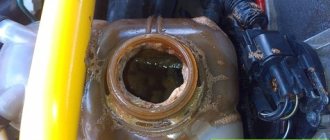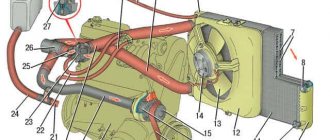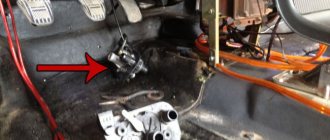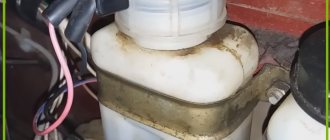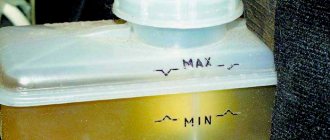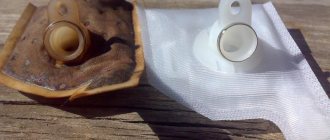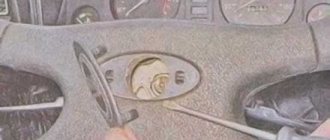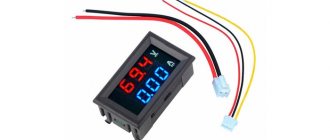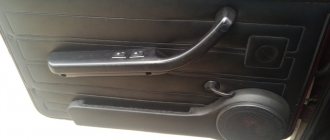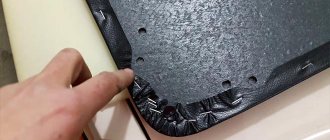How to find out what is in the cooling system of a car
Replacing antifreeze in a Chevrolet Lanos 1.5 is not a complicated procedure, but it is much more difficult to choose the appropriate coolant that will ensure efficient engine operation (meaning, it will ensure quick warming up of the engine in winter and cooling it in summer). Which coolant is best to fill into a car is described in detail in this material. Today we will learn how to determine what kind of coolant is poured into the cooling system of Lanos, Sense and Chance cars, how to determine the need for replacement, and also how to replace antifreeze with your own hands.
If you forgot or bought a car, but did not find out from the previous owner what type of refrigerant he used, then you can find out on your own. Two types of refrigerants are used as coolants - antifreeze and antifreeze. To find out what type of coolant is filled, you need to pay attention to the following factors:
- Resistance to frost - for this it is not necessary to wait for the arrival of cold weather.
Fill the bottle with some liquid from the expansion tank and place it in the freezer. If after 20-30 minutes the coolant does not freeze, then it is high-quality antifreeze. Freezing of the liquid indicates that low-quality antifreeze has been poured into the system. - Color -
antifreeze is painted blue, and coolant has different color options. If there is blue liquid in the tank, then there is a high probability that antifreeze is poured into the system. Few people know, but antifreeze was also produced in red color, and it had a crystallization temperature of -65 degrees. However, such liquids were not available for free sale, but were intended for use in harsh polar conditions. - Use a hydrometer - this is a special device for determining density.
The density of antifreeze ranges from 1.073 to 1.079 g/cm3, and antifreeze has a lower density.
Antifreeze, which was produced back in the 70s under the USSR, differed from modern analogues in its high quality. In addition to its resistance to boiling and crystallization, the antifreeze changed its color as the amount of additives was reduced. When the blue liquid became colorless, it meant it needed to be replaced. The production of high-quality antifreeze continued until the 90s, after which production was curtailed and closed. However, liquids with the name “Antifreeze” continued to be produced, but only at various enterprises in the Russian Federation.
Modern antifreeze manufacturers make it using inorganic compounds and other substances that do not meet standards. This leads to the fact that the liquids work for no more than 2 years, and have a low boiling point (up to 110 degrees). Based on the current historical situation with antifreeze, today many motorists prefer to use foreign analogues, which cannot be called wrong. Using one of the above methods, you can understand what exactly is poured into the Lanos cooling system.
How to determine the need to replace the coolant on Lanos
Information on how often you need to change the coolant on your car is very useful. However, it is not always relevant, since few car owners remember when the last replacement was made. To determine whether it is time to change antifreeze on Lanos, Sense and Chance, you need to rely on some methods.
This is interesting!
The service life of the coolant depends not only on the manufacturer’s recommendations, but also on the quality and type of coolant, as well as the material of the radiators used. For comparison, the manufacturer of Lanos, Sense and Chance cars recommends replacing the coolant every 40,000 km or 3-4 years, while Volkswagen gives a lifetime service life.
Today, manufacturers are producing a new generation of antifreeze, the service life of which has been increased to 200 thousand km. This resource is determined by the presence of anti-corrosion additives. It is not rational to buy such an expensive refrigerant for a budget car, so when using antifreeze, it should be changed every 3-4 years.
You can determine the need to replace antifreeze on Lanos by the state of the refrigerant. The liquid must be clean and free of dirt, rust and other deposits. If the condition of the fluid is not satisfactory, it should be replaced and the system flushed. It is recommended to change directly to the type of fluid that was poured into the system from the factory. You can find out the type of fluid in the technical documentation for the car. However, finding a similar brand of refrigerant can be problematic, so we use the most suitable type of coolant.
How much antifreeze does the cooling system of Chevrolet and Daewoo Lanos hold?
Before you replace the coolant with Lanos 1.5, you will need to initially purchase the required amount of refrigerant. For each car model, the amount of coolant is different. The required amount of antifreeze is indicated directly in the technical documentation for the car.
The capacity of the cooling system for Lanos, Sense and Chance is 7 liters. This is exactly the amount of coolant that will need to be purchased in advance before replacing it. However, during the replacement process, you may encounter the fact that some of the liquid being poured will remain - approximately 1.5-2 liters. This is due to the fact that it is almost impossible to drain all the liquid from the system. That is why 5 liters of new antifreeze (3.5 liter concentrate) is enough, poured into the engine cooling system of Chevrolet, Daewoo and ZAZ Lanos.
Replacement frequency, what antifreeze to fill
According to the regulations, the recommended maintenance for replacing the coolant is specified by the manufacturer to be performed once every 4 years or after 40,000 kilometers. As for subsequent replacements, you need to be guided by the information on the canister of the product being poured.
The best choice for filling as a new fluid would be to use the original General Motors Dex-Cool Longlife product. It is produced in the form of a concentrate and has the following articles and order codes: 93170402 (1 l.), 93742646 (2 l.), 93742647 (2 l.).
In addition to the original product, you can purchase its complete analogues, Havoline XLC or Coolstream Premium. The latter, by the way, went to a plant located near St. Petersburg and was used as the first fill.
You can go the other way and look for antifreezes that meet the approval that the automaker requires for use in Chevrolet Lanos. One of these is Kroon Oil Antifreeze SP 12. Many car enthusiasts highlight its quality properties, as well as its long service life.
How much antifreeze is in the cooling system, volume table
| Model | Engine capacity | How many liters of antifreeze are in the system | Original liquid / analogues |
| Chevrolet Lanos | gasoline 1.6 | 7.0 | Genuine General Motors Dex-Cool Longlife |
| gasoline 1.5 | Havoline XLC | ||
| gasoline 1.4 | Coolstream Premium | ||
| gasoline 1.3 | Kroon Oil Antifreeze SP 12 |
What antifreeze to pour into the engine cooling system of Lanos, Sens and Chance
Today there are a large number of types of coolants on the market. Which type of coolant is best to choose depends on many factors. To decide which antifreeze to pour into the Lanos engine cooling system, you should familiarize yourself with this material, on the basis of which you can make the right decision.
Experts recommend pouring antifreeze into Lanos of the same brand that was originally filled from the factory. In this case, you won’t even need to flush the system first. If a different brand of antifreeze is selected (in most cases), then a system flushing procedure is carried out before replacement.
Replacing coolant on Lanos and the necessary tools
If your vehicle's coolant reservoir looks like this, then replacement is necessary.
After deciding on the quantity and brand of liquid, you should prepare the tools. Required:
- Screwdriver.
- Pliers.
- Capacity.
- The key is "10".
- Jack.
- Watering can.
Instructions and exact algorithm
- Replacement is carried out only on a cold engine. The car must first be placed on a level surface. Next, there is a plug at the bottom of the radiator and it unscrews.
Place the car on a level surface and wait until the engine cools down.
The coolant drain plug is indicated by an arrow.
Be prepared to see such a "kaku".
We removed the pipe so that the antifreeze would drain faster.
If after draining the coolant you see such dirt, then flushing the cooling system is necessary.
Fill in new antifreeze.
We control the risks.
Video about how antifreeze is drained from a Chevrolet Lanos
What is needed to replace antifreeze on Chevrolet and Daewoo Lanos
Before carrying out work on replacing antifreeze and antifreeze on Lanos, you should make sure that you have the necessary tools. The replacement procedure is not difficult, and there is no need to go to a car service center to carry out the replacement. Even a beginner can cope with this task by first preparing the necessary equipment, materials and tools. To replace the refrigerant on Lanos, you should make sure you have the following tools:
- Set of keys and screwdrivers
- Pliers
- Jack
- A container for draining old fluid of at least 5 liters. Draining refrigerant into the ground is strictly prohibited, as this is harmful to the environment. After draining the liquid into the container, it should be disposed of. Antifreeze contains ethylene glycol, which contributes to the development of cancer.
The materials you will need are antifreeze or antifreeze in the required quantity. If the antifreeze is not diluted, then distilled water is purchased separately. To flush the system, you will need a can of special liquid (reagent), which is poured into the system, mixed with the old refrigerant.
Considering the fact that 1.5-2 liters of water remains in the system after draining, which is due to the design of the engine system, when using concentrate you will need to dilute it in the following amount:
- Mix 3.5 liters of concentrate with 1.5 liters of distilled water
- You cannot use ordinary water to dilute the concentrate, as it freezes at subzero temperatures.
When all the preparatory work has been completed, all that remains is to begin the relevant replacement work. First, let's look at how to flush the engine cooling system on Lanos.
How to pre-flush a car's cooling system
Before replacing antifreeze on Lanos, Sense and Chance, it is necessary to flush the system. This procedure is not at all mandatory, but it is recommended in the following situations:
- When the type of coolant changes, for example, if antifreeze has been added and it is planned to use antifreeze
- When changing the type of refrigerant, for example, if G11 antifreeze was previously filled, and it is planned to use G12 or G13
- If the refrigerant being drained is red in color and shows signs of blockages
The primary rinsing process involves performing the following manipulations:
- For flushing, a special liquid is used - a reagent, which is poured into the expansion barrel. Before adding flushing fluid, you need to warm up the engine to operating temperature.
- Add fluid and let the engine idle for at least 10-20 minutes.
- In this case, you should turn on the heater in the car to maximum in order to flush the heater radiator
After the engine has been running for 10-15 minutes, you can turn it off and begin draining and replacing the refrigerant. How to replace antifreeze on Chevrolet and Daewoo Lanos, we will consider in detail below.
This is interesting!
Some recommend flushing the system with reagents with ordinary or distilled water, which is poured into the system after draining the coolant. However, reagent manufacturers recommend mixing the composition with antifreeze or antifreeze, which improves flushing properties.
How to change coolant
Antifreeze should be replaced after the engine has completely cooled down. It is also important that the car is installed on a relatively level area.
How to drain
- We twist the drain plug, it is located on the left of the radiator.
Location of the drain plug Having previously placed a previously prepared container for draining the waste liquid, unscrew the tank plug.
Expansion tank plug
How to fill
- After all previous operations have been completed, pour new coolant into the tank until its level reaches the MAX mark on the expansion tank. We start the engine and wait for the fan to work.
- To better fill the system with liquid and to prevent air locks from forming, be sure to squeeze the radiator pipes with your hands while filling.
- Turn off the engine. Check the antifreeze level in the tank.
- If necessary, add coolant until it reaches the “MAX” mark.
